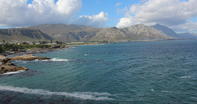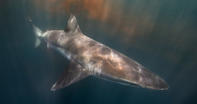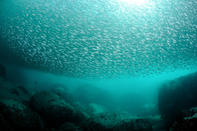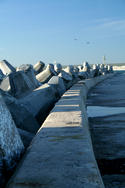The Ocean’s Carbon Processors
In order to comprehend the content, you will need a glass of water by your side. Preferably sea water, but water from a nearby stream or pond or dam will also do. Definitely not municipal tap water or pool water. We want living water – untreated, unchlorinated, unfiltered, unadulterated.

For in that water, you will find a whole host of little wandering creatures. Drifters, things usually too small for the human eye to see without the prosthetic aid of a microscope. These are creatures that hover in the water, mostly unnoticed by us, but are as critical to life in water as three square meals a day are for you and me. We’re talking about plankton, whose name derives from the Greek word meaning “drifter” or “wanderer”.
As far as ocean life is concerned, it all starts with the phytoplankton – the plant equivalent of these microscopic floating organisms – occurring near the water’s surface. Just as green plants on land take in carbon dioxide from the air around them, drink a bit of water and then use the sun’s energy to convert that into oxygen and carbohydrates, phytoplankton is the ocean’s carbon processors.
Of all the carbon dioxide emissions, put into the air every year by human activities worldwide, something like 40 per cent is then stripped back out of the atmosphere by terrestrial plants and the ocean (not all of the ocean’s carbon absorption actions come from phytoplankton). These are known as carbon “sinks”. Without them, greenhouse gases would build up in the atmosphere much faster than it has been over the years.
Upwellings Bring Food

Once the marine algae have bloomed, the microscopic herbivores move in to feed, bringing the rest of the food chain with them. Intriguingly, the abundance of zooplankton in the Benguela Current is climbing. During the past fifty years, their numbers have climbed about 10 fold, and the Benguela Current Large Marine Ecosystem Programme (BCLMEP) scientists link this directly to a measured increase in southerly wind speeds in the area.
Winds blowing up from the south (who was it that decided winds should be named after the direction they’re blowing from, rather than the direction they’re blowing to?) drive the warm surface water away from the coast, forcing cold and nutrient-loaded waters to rush up from the ocean floor. It makes sense, then, that if you put your foot on the accelerator, namely the wind, you’re going to speed up the entire Benguela upwelling process.
Faster wind, greater upwelling, more nutrients, more algae. Wham! The food chain gets fuel injected. This has some interesting implications for the rock lobster, a mainstay of many West Coast villagers.
Oxygen Depletion
Ordinarily, more food on one’s plate might be a good thing. But for the rock lobster, this can go catastrophically wrong. Every now and then, after a period of strong summer upwelling, when the nutrient load in the water is high and the algae bloom abundant, the winds falter and, for a moment, cease.
Instead of being blown out to sea and dispersed, the algae build up in the near-shore waters, staining it red and bleeding toxins into it. The plants quickly use up all the nutrients in the water and begin to die off. Bacteria do their work on the dead plant matter, bringing on the rot and using up all the available oxygen in the water in the process.
Without the usual wind action to churn up the sea and keep it oxygenated all the way down through the water column, life on the ocean floor begins to suffocate. Once the bacteria are forced to continue their decomposition work in the absence of oxygen, in an anaerobic state, they start releasing hydrogen sulphide into the water, with the telltale stink of rotten eggs. Should this poisonous, acidic, low-oxygen water be swept shore-ward and into the shallows, it can sterilise an entire bay.
Marine life has devised its own way of extracting oxygen from the sea water. Drop the oxygen levels in that water and it’s no different to depriving life on land of oxygen. Anything caught up in that death tide is at risk: mussels, sea snails, cuttlefish, crabs, squid, you name it. The BCLMEP folk believe that a similar low oxygen event off Namibia during the 1990s might have been responsible for plummeting hake stocks, “which have not recovered despite conservative management actions”.
Sea Surface Warming

The predictions for the Benguela system look something like this: Because air warms faster than water – this means that sea surface warming along our coast will follow about 20 years behind the air warming over land, which is predicted to be by 1.5°C along the coast by 2050.
Wind speed will continue to pick up in speed, bringing greater upwelling and, with it, the likelihood of harmful algal blooms, low oxygen events, and disruption to the spawning processes of surface-breeding fish such as anchovies and sardines. This, combined with over-exploitation of the fisheries, could be disastrous to fish stocks.
Fish Stock Recovery Slow

Thankfully, because there is little development very close to the water’s edge along this coast, sea level rise is not expected to have huge social or economic fallout here. Warming events might slow or hinder the recovery of fish stocks, even if strict measures are put in place to decrease fishing pressure.
Over harvesting of lobsters and increased pressure from low oxygen events will continue to assert themselves on West Coast populations, while in Walker Bay, rock lobsters are on the increase. Whether these trends are the consequence of entirely natural long-term marine cycles or the offshoot of rising global temperatures associated with rising carbon dioxide in the atmosphere, the end result is certain: the villages and fishing-related industries along the West Coast face a future of economic hardship.
By Leonie Joubert